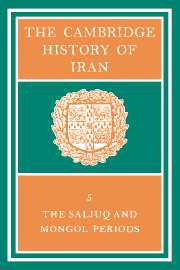Book contents
- Frontmatter
- 1 THE POLITICAL AND DYNASTIC HISTORY OF THE IRANIAN WORLD (A.D. 1000–1217)
- 2 THE INTERNAL STRUCTURE OF THE SALJUQ EMPIRE
- 3 RELIGION IN THE SALJUQ PERIOD
- 4 DYNASTIC AND POLITICAL HISTORY OF THE IL-KHĀNS
- 5 THE ISMĀ‘ĪLĪ STATE
- 6 THE SOCIO-ECONOMIC CONDITION OF IRAN UNDER THE ĪL-KHĀNS
- 7 RELIGION UNDER THE MONGOLS
- 8 POETS AND PROSE WRITERS OF THE LATE SALJUQ AND MONGOL PERIODS
- 9 THE VISUAL ARTS, 1050–1350
- 10 THE EXACT SCIENCES IN IRAN UNDER THE SALJUQS AND MONGOLS
- Bibliography
- Index
- Plate section
- References
2 - THE INTERNAL STRUCTURE OF THE SALJUQ EMPIRE
Published online by Cambridge University Press: 28 March 2008
- Frontmatter
- 1 THE POLITICAL AND DYNASTIC HISTORY OF THE IRANIAN WORLD (A.D. 1000–1217)
- 2 THE INTERNAL STRUCTURE OF THE SALJUQ EMPIRE
- 3 RELIGION IN THE SALJUQ PERIOD
- 4 DYNASTIC AND POLITICAL HISTORY OF THE IL-KHĀNS
- 5 THE ISMĀ‘ĪLĪ STATE
- 6 THE SOCIO-ECONOMIC CONDITION OF IRAN UNDER THE ĪL-KHĀNS
- 7 RELIGION UNDER THE MONGOLS
- 8 POETS AND PROSE WRITERS OF THE LATE SALJUQ AND MONGOL PERIODS
- 9 THE VISUAL ARTS, 1050–1350
- 10 THE EXACT SCIENCES IN IRAN UNDER THE SALJUQS AND MONGOLS
- Bibliography
- Index
- Plate section
- References
Summary
The period of the Great Saljuqs can largely be regarded as representing or corresponding to the early Middle Ages. To make this division is not to underestimate the fundamental fact of the unbroken thread of Persian history in Islamic times. Stretching back behind the Saljuq period is a long continuity of administrative practice, but under the Saljuqs the old institutions gained a new meaning; developments that had begun in the preceding period crystallized, and new elements of worth were added to the Persian heritage. The Saljuqs did not formulate the details of the new system: this was mainly the work of the officials of the bureaucracy and of the religious institution, who were for the most part Persians and not Turks. But the Saljuqs were in some measure responsible for the spirit in which the new system worked.
Many Saljuq institutions lasted in their outward forms (though the terminology was in some cases changed) until the twentieth century; and without a knowledge of these, and an attempt to trace them back to earlier times, we cannot fully comprehend the questions that began to agitate Iran in the nineteenth century and the solutions sought to them. Politically and religiously Iran has travelled far from the theory of a theocracy in which the caliph exercised constituent authority and legitimized the sultan's assumption of power; and economically from the iqtā‘ in its various forms and the guilds and corporations of Saljuq society. But it was not until the twentieth century that the Constitutional Revolution separated modern Iran from medieval Persia.
- Type
- Chapter
- Information
- The Cambridge History of Iran , pp. 203 - 282Publisher: Cambridge University PressPrint publication year: 1968
References
- 11
- Cited by

